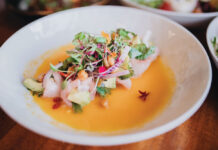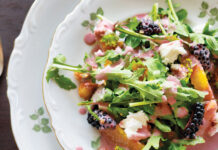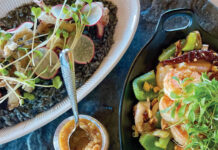Story by Molly & James Jacobson
 We were starving when we met.
We were starving when we met.
James was heading for Lahaina, where friends would soon be steaming Maryland crabs. He could already taste the tender chunks of sweet meat and warm, salty butter.
Molly was walking along Kama‘ole Beach, savoring her first Maui sunset and wondering where to find a good meal.
His cell phone rang. The FedEx package—teeming with live, succulent crabs—had been stolen. No feast. As he pulled off the road, James noticed the text message: That girl he had met on the Internet was visiting Maui and wanted to know where to get sushi. Within minutes, it was a scene from a vintage peanut-butter-cup commercial: We were unexpectedly perfect together.
And still starving.
That evening we shared sashimi morsels and sipped sake from tiny cups. The meal launched a love affair. It also birthed Top Maui Restaurants, our annual tell-it-like-it-is restaurant guide to dining on Maui. The serious (and seriously hedonistic) mission we undertake is that of every restaurant critic: to advise readers about where to eat and whether it’s worth the money.
The sensual pleasures of our work cannot be denied. Life is a buffet, and we load our plate with everything from buttery steaks to delicate fresh fish to comforting soups to warm, sticky, spicy cinnamon rolls.
Still, this is work. Between bites we are busy recording, considering, weighing, comparing. We whisper at the table (sometimes a glance will do), scribble notes in a bathroom stall (Molly), or send ourselves emails (James). On the way home, we turn on the recorder and rattle off our thoughts. If needed, we reference cookbooks, magazine articles, and (non-Maui) chef friends. A review may only take three minutes to read, but hours to write.
Our expertise? Molly cooked family meals from the age of nine and dined out at least twice a day for ten years in the restaurant meccas of Boston and New York. James studied Ayurvedic Indian cuisine with Mother Teresa’s personal chef, and French cooking at Le Cordon Bleu. We also adhere to ethical guidelines for restaurant criticism that were established decades ago and codified by the Association of Food Journalists. While “Yelpers” and “Trip Advisors” can get away with a review after one visit (“We had to wait for our table! One Star!!”), a professional restaurant critic must go at least three times, pay for each meal, dine unannounced (anonymously, if possible), order a variety of dishes, and give new restaurants at least three months to stabilize before reviewing.
Maui restaurateurs face several challenges, including a transient work force and extreme fluctuations in the number of visitors from season to season. Maui’s lovely views come with a high cost of living and outrageously expensive overhead. Even those firmly committed to serving fresh, local ingredients may have unreliable access; if the bean-sprout guy doesn’t show up on time, or the lettuce guy finds aphids on his crop, there may be nowhere else to turn but a commercial restaurant supplier importing mainland ingredients.
Keeping this in mind, we judge whether a restaurant is doing its best with what it has. For example, outdated décor can be forgiven if the restaurant is sparkling clean (particularly the bathrooms and the kitchen). Vegetables from a commercial supplier can still be diced and sliced evenly, and frozen fish—while it will never compare to fresh—can still be cooked until flakey (not rubbery). With steady employee turnover there should be steady training; sloppy, slow, or rude servers can guarantee a customer never returns.
If the owner is not on top of these issues, even the most glamorous-seeming restaurants can offer disastrous meals. This is why our slogan is:
“We eat bad food, so you don’t have to.”
Recently, an order for a small bowl of seafood chowder turned up a platter of coconut-cream-flavored gelatin. The crab was fake, the squid rubbery, the scallops like little pencil erasers, and the shrimp flayed into sad butterflies. The “soup” was a pudding of concentrated sugar in coconut cream (not milk) and bore the faintest whiff of ammonia.
It can be fun to write about a disgusting meal, and readers love a snarky review. But being a critic isn’t about being negative for the sake of negativity. It’s about evaluating what’s on the plate, good, bad, or mediocre.
Excellent ingredients prepared well generally make a very good dish. But some chefs infuse a special “X factor” into their food. We call it love.
If we momentarily forget that we are working—lost in the taste, texture, and aroma of a dish—we declare it “full of love.” And it doesn’t have to be an expensive concoction; a silky, spicy tom ka ghai (ginger coconut soup) can stop time with one slurp.
We began measuring food’s love quotient when Molly first tasted carpaccio made with paper-thin slices of beef, a spicy arugula salad, and crispy fried capers. She took a bite and felt a wave of sensations rippling deep into her body. When she could speak again, she said, “Either the chef is deeply in love with me, or he is deeply in love with this dish.” A few years later, the same preparation—while executed flawlessly and still delicious—was not mind-blowing. It was missing the love.
If a chef cares about his diners, the simplest of salad dressings drizzled over crisp greens and carefully sliced cucumbers can convert a casual diner into a repeat customer with one bite. If you’ve ever left a restaurant feeling nourished in your soul, you’ve had food made with love.
Maui is a small island, and assessing local businesses has its risks. We’ve received rude and anonymous phone messages, cold shoulders in public, and even had soup dumped in our lap. (We can’t be sure that the soup incident was retaliatory; perhaps the server was just nervous because we’d been recognized by the manager, who barked, “I read your book—I’m surprised you still eat here.”)
Which may beg an obvious question: Who needs restaurant critics, anyway? Owners and chefs do, according to Gael Greene, who was the New York Magazine restaurant critic for nearly forty years. Greene’s flamboyant and dead-accurate reviews helped make New York City’s dining scene the super-sexy multicultural food capital it is today.
In a recent phone interview, Greene told James,
“If you have put together a really extraordinary restaurant—or even a great burger joint—the intelligent critic can be your best publicist. The critic who sees what you have done, [and] has passion for food, translates that passion into words [that] draw people into your business to see if in fact it’s true . . . that is a huge, positive way that a restaurant critic serves the public and the restaurant.”
Pointing out that even the most well-known emperors might need to get real and put on some clothes is part of the job.
Greene remembers when Jean-Georges Vongerichten (who has since opened the Kaua‘i Grill in Princeville) changed the way he cooked after reading her review, which said he was “too French, too formal, too predictable.”
“He stopped using stock made with bones and began doing this incredible, revolutionary cooking using broths and purees of vegetable to thicken the sauce. . . . The first time he told me that [I had influenced him], I thought he was just buttering me up.” Not so. In an interview for Martha Stewart Radio, the famous chef admitted the profound impact of Greene’s review.
Although chefs may cringe, criticism—objective, discerning evaluation and analysis—is crucial to making art. Critics challenge artists (dancers, musicians, actors, painters, chefs) to push their creativity to the limit, ultimately elevating the entire form to higher levels of achievement. Who else but a critic is going to tell you exactly what it’s really like to sit at your table and eat your food? Perhaps this is why we have received thank you notes and private requests to “keep writing the truth” from Maui restaurateurs and chefs.
We’re not sure we could stop if we tried to.





